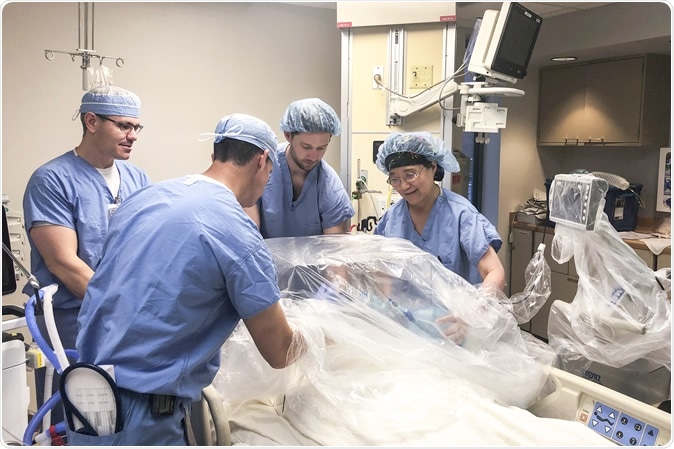Boxes, barriers, and shields of various types and designs are making their appearance the world around to protect vulnerable healthcare professionals and allied staff from picking up COVID-19 while undertaking their duties. One such new device is the intubation box from West Virginia University (WVU).
Tracheal intubation, usually simply referred to as intubation, is the placement of a flexible plastic tube into the trachea (windpipe) to maintain an open airway or to serve as a conduit through which to administer certain drugs. It is frequently performed in critically injured, ill, or anesthetized patients to facilitate ventilation of the lungs, including mechanical ventilation.
The story behind the intubation box
Every health professional is worried about the possibility of being infected with COVID-19 during the course of seeing and caring for patients, whether they are known to have the infection or not. One faculty member at WVU was especially anxious because of the exposure her husband, pediatrics head Dr. Chuck Mullett, faced every day during his clinical work. Lee Mullett, assistant professor and involved with the interior design program at one of the WVU institutions, took her worry a step further.
Once she came across a report on intubation boxes designed to protect doctors from aerosol and droplet transmission during the high-risk time of intubation, she prompted her husband to investigate. He, in turn, informed his colleague Dr. Pavithra Ellison who worked in pediatric anesthesiology and also worried about their exposure to the virus.
Some fields of medicine are at exceptionally high risk for the spread of infection. For instance, physicians need to intubate patients who require mechanical ventilators. The procedure may excite gagging and the escape of infectious virus-carrying particles in aerosol form. This risk is faced by anesthesiologists and respiratory therapists, as well, and medical personnel in the emergency and critical care departments.
Lee Mullett decided to take action. She had earlier visited the Innovation Hub in the campus. Now she asked the director, Gene Cilento if he could help. This was during the early part of the shutdown due to the spread of the virus.
Cilento remarks, “The bottom line is that the new Innovation Hub is still coming online, but we saw an opportunity to help the medical profession in a critical time of need.” The team at the Hub, including senior engineers and shop managers, began to design their own box inspired by the report of similar devices cropping up in hospitals around the world. They first consulted medics at the WVU School of Medicine to get input on how to make the boxes sturdy, comfortable, and functional, capable of being sterilized, and adequately protective.
The design included access ports that would help the physician to do intubation from outside the box. The ports needed to be shielded to prevent cuts and scrapes from any inadvertent movements by the patient or medical personnel but had to provide a perfect seal.

Dr. Matthew Ellison, Dr. Kevin McKillion, Dr. Hong Wang and CRNA Cole Mortellaro, the WVU Medicine anesthesia team practice COVID-19 intubations using the intubation box created in the Innovation Hub. The suite was set up by the trauma and critical care institute specifically for COVD-19 practice in the hospital. Intubation boxes help decrease aerosol spread from infected patients. (WVU Photo)
The boxes were also needed on an urgent basis, which meant no shopping for new equipment. Says senior lab instrumentation specialist Jim Hall, “We had to make it work with the equipment we had, keeping in mind that we needed to get them out the door as quickly as possible.”
Once shop manager Joshua Bintrim built the first rapid prototype, he received feedback from doctors in real-time. This helped him see how the box was actually used, and the final improved model was chosen – a box with three sides, measuring 20 inches each way, with two holes, every 6 inches in diameter. The ability to compare notes virtually using WhatsApp meant that only one iteration was needed before the start of actual production. Once the learning curve is addressed, says Hall, it takes only half an hour to make a single intubation box.
Chuck Mullett is impressed: “They were perfect—so simple, and yet so effective.” The hospital asked for 40 boxes in all, for use in the emergency departments, the operating rooms and the intensive care units where the risk of aerosolization during intubation is at its peak. They got the boxes within a week.
Describing the effort as a “truly collaborative” one, Ellison says it taught her that the amount that could be accomplished in a short period was remarkable. She says she works with “an incredible team of professionals,” and that “The positive part of this is how we all work together as a team to help protect patients and also all our healthcare personnel.”
Aerosol boxes have been recommended and designed before this in various parts of the world, including India and the UK, and have been found to be efficient at containing infectious respiratory aerosols, while being easily sterilizable and inexpensive. Their use may require initial training, which may be difficult in the present situations where medical staff are already overstretched. The procedure may be rendered difficult with the box in place in cases where the patient is obese, propped up, has a short neck, and other situations where manipulation is already impaired. However, they do offer significant protection in some uncomplicated cases, and better designs, such as the one from WVU, are to be sought.
The Innovation Hub has, meanwhile, extended its operations to the VA Hospital System in West Virginia, as well.